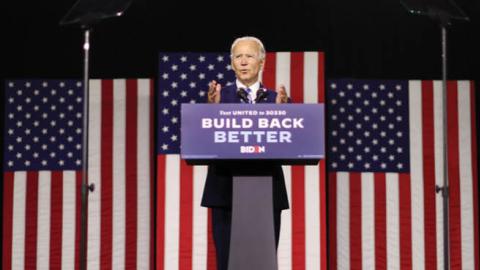In his recent speeches in Scranton, Pa., and Wilmington, Del., Joe Biden began outlining a plan to reinvigorate the U.S. economy in the wake of the pandemic and resulting economic crash. The Democratic nominee’s call for $700 billion in new government spending on domestic manufacturing and research and development, as well as another $2 trillion on clean energy, may appear attractive at first. But the plan is likely to produce results as disappointing — to put it mildly — as the last spending program he oversaw, a mess described below.
At the theoretical level, Biden’s proposed subsidies for manufacturing make some sense. China’s increasingly aggressive behavior and its coverup of the pandemic have exposed the complacency that characterized much of America’s post–Cold War foreign and trade policy. As China (and, perhaps, other countries too) grow more belligerent and foreign supply chains become less secure, it is prudent for the U.S. government to protect strategically vital industrial capacity. Under the circumstances, depending on other nations for the steel needed to, say, build nuclear submarines is a high-stakes gamble; so too is going without the ability to mass-produce a treatment or a vaccine to fight the current pandemic — or, for that matter, the next. As the pandemic has shown, the variety and severity of threats to national well-being are growing, as is the urgency of maintaining the capabilities needed to respond swiftly.
Increased government spending on research and development can be beneficial too. As Mark P. Mills and M. Anthony Mills have shown, many of the “moonshot” programs that created the most dazzling technologies of the 20th century came from theoretical discoveries that long predated their eventual application and were helped along at various stages by government funding. Today, the national-security establishment frets that China’s research programs, which target emerging high-tech industries, will rob the United States of its technological edge, and many call for the United States to boost its scientific spending to Cold War–era levels.
But, however desirable some of these programs might be in theory, cost considerations cannot be thrown out the window. To be sure, the Reagan defense buildup forced the Soviets into an arms race that hastened their demise, but the United States could afford to play this game in part because, to a greater or lesser extent, the government’s burden on the economy had been manageable for the preceding 35 years. Given current government-debt levels, the dollar figure attached to Biden’s proposals should raise eyebrows. His package is 318 times larger than that of Japan, which has earmarked about $2.2 billion to subsidize the reshoring of industries. Various factors complicate a direct comparison between the two, but even after adjusting for those, the discrepancy is striking.
A look back at the last major spending bill supervised by Biden suggests a possible reason for the higher price tag. After passing the 2009 stimulus bill, President Obama handed implementation off to “ Sheriff Joe, ” who purportedly “took it personally” when funds were misspent. If so, there was a lot to rouse his ire. Environmental activist Michael Shellenberger, who co-authored the proposal that inspired the green-energy spending in the Obama stimulus bill, describes in Apocalypse Never his dismay at how it was allocated. One loan program doled out 80 percent of its funds to companies affiliated with Obama-campaign donors and bundlers, and the Government Accountability Office found that the Department of Energy “treated applicants inconsistently in the application review process, favoring some applicants and disadvantaging others.”
Another difficulty is that Biden’s policies work at cross purposes with one another, at least so far as the economy is concerned. In his Wilmington address on energy policy, Biden proposed spending $2 trillion to make irreversible steps toward a carbon-free electric grid in 2035. That is more than enough to convert the U.S. power grid entirely to carbon-free and dependable nuclear and hydroelectric power.
Sadly, tilting with windmills may be more destructive than tilting at them. Biden’s energy policy will make electricity more expensive and thus burn through his manufacturing subsidies. Although solar and wind have become cost-competitive at producing energy in certain conditions, they are held hostage by the weather. Last summer, energy prices in Texas surged over 40,000 percent during a week when the weather was hot and the breeze light. Wind currently generates one-third of Texas’s energy; imagine running a factory that is entirely weather-dependent.
Many power companies compensate for this by continuously operating natural-gas plants — which are the best option for accommodating wind’s and solar’s rapid and unpredictable shifts — to make up for clouds and calms, but that strategy requires building and operating much more capacity than is needed. With his 2035 goal in mind, Biden will restrict natural-gas infrastructure and drive up that price too.
Biden is trying to appeal to many different constituencies and (he hopes) unify the country. That may be easier to achieve on the campaign trail than in the White House. Governing would force him to choose between helping manufacturing and proceeding along the path to net-zero emissions. Depending on his choice, the taxpayer could spend a lot of money for nothing.
Read in National Review

















